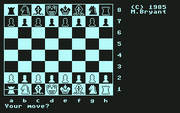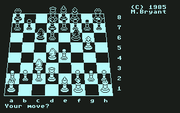
Colossus Chess
Encyclopedia
Colossus Chess is a series of chess-playing computer programs developed by Martin Bryant
, commercially available for various home computer
s in the 1980s.

 Bryant started Colossus Chess in 1983, using his White Knight Mk 11 program, winner of the 1983 European Microcomputer Chess Championship, as a basis. It was developed on an Apple II
Bryant started Colossus Chess in 1983, using his White Knight Mk 11 program, winner of the 1983 European Microcomputer Chess Championship, as a basis. It was developed on an Apple II
, but was first commercially released for Commodore 64
as Colossus Chess 2.0 (CDS Micro Systems, 1984). A number of releases for 8-bit microcomputers followed. Version 3.0 was released in 1984 for the Atari 8-bit family
of computers (published by English Software
), followed by 4.0 in 1985 which was released on most formats of the day (published by CDS).
Colossus Chess featured time-control
led play with game clock
s, an opening book with 3,000 positions, and problem
-solving mode that could solve normal mates, selfmate
s and helpmate
s. Pondering on opponent's time and a three-dimensional chessboard
were introduced in Colossus Chess 4.0. All releases were written in the assembly language
of the appropriate CPU; the ZX Spectrum
version could examine an average of 170 positions per second.
Uncommon for microcomputer chess programs of the era, Colossus had a full implementation of the rules of chess
, including underpromotion, the fifty-move rule, draw by repetition, and draw
by insufficient material. Colossus was also able to execute all the basic checkmate
s, including the difficult bishop and knight checkmate
.
 The program was subsequently ported to Atari ST
The program was subsequently ported to Atari ST
(1988), Amiga
(1989) and IBM PC
(1990) under the title Colossus Chess X. The new releases featured four chess sets and enhanced graphics developed with the assistance of Gary Thomlinson and Carl Cropley. The opening book was extended to 11,000 positions, and the program had the ability to learn from past playing experiences.
. It was written in C#, then converted to C
for speed, and was finally publicly released in 2006. , the latest version is 2008b.
Martin Bryant (programmer)
Martin Bryant is a British computer programmer known as the author of Colossus Chess, a 1980s commercial chess-playing program, and Colossus Draughts, gold medal winner at the 2nd Computer Olympiad in 1990.- Computer chess :...
, commercially available for various home computer
Home computer
Home computers were a class of microcomputers entering the market in 1977, and becoming increasingly common during the 1980s. They were marketed to consumers as affordable and accessible computers that, for the first time, were intended for the use of a single nontechnical user...
s in the 1980s.
Colossus Chess


Apple II
The Apple II is an 8-bit home computer, one of the first highly successful mass-produced microcomputer products, designed primarily by Steve Wozniak, manufactured by Apple Computer and introduced in 1977...
, but was first commercially released for Commodore 64
Commodore 64
The Commodore 64 is an 8-bit home computer introduced by Commodore International in January 1982.Volume production started in the spring of 1982, with machines being released on to the market in August at a price of US$595...
as Colossus Chess 2.0 (CDS Micro Systems, 1984). A number of releases for 8-bit microcomputers followed. Version 3.0 was released in 1984 for the Atari 8-bit family
Atari 8-bit family
The Atari 8-bit family is a series of 8-bit home computers manufactured from 1979 to 1992. All are based on the MOS Technology 6502 CPU and were the first home computers designed with custom coprocessor chips...
of computers (published by English Software
English Software
English Software was a software developer and publisher in the 1980s based in Manchester, UK.- History :The company was set up in 1982 by Philip Morris, owner of Gemini Electronics computer store in Manchester, to release video games for the Atari 8-bit home computers...
), followed by 4.0 in 1985 which was released on most formats of the day (published by CDS).
Colossus Chess featured time-control
Time control
A time control is a mechanism in the tournament play of almost all two-player board games so that each round of the match can finish in a timely way and the tournament can proceed. Time controls are typically enforced by means of a game clock...
led play with game clock
Game clock
A game clock consists of two adjacent clocks and buttons to stop one clock while starting the other, such that the two component clocks never run simultaneously. Game clocks are used in two-player games where the players move in turn...
s, an opening book with 3,000 positions, and problem
Chess problem
A chess problem, also called a chess composition, is a puzzle set by somebody using chess pieces on a chess board, that presents the solver with a particular task to be achieved. For instance, a position might be given with the instruction that White is to move first, and checkmate Black in two...
-solving mode that could solve normal mates, selfmate
Selfmate
A selfmate is a chess problem in which white, moving first, must force black to deliver checkmate within a specified number of moves against his will. Selfmates were once known as sui-mates.The problem to the right is a relatively simple example...
s and helpmate
Helpmate
A helpmate is a type of chess problem in which both sides cooperate in order to achieve the goal of checkmating Black. In a helpmate in n moves, Black moves first, then White, each side moving n times, to culminate in White's nth move checkmating Black...
s. Pondering on opponent's time and a three-dimensional chessboard
Chessboard
A chessboard is the type of checkerboard used in the board game chess, and consists of 64 squares arranged in two alternating colors...
were introduced in Colossus Chess 4.0. All releases were written in the assembly language
Assembly language
An assembly language is a low-level programming language for computers, microprocessors, microcontrollers, and other programmable devices. It implements a symbolic representation of the machine codes and other constants needed to program a given CPU architecture...
of the appropriate CPU; the ZX Spectrum
ZX Spectrum
The ZX Spectrum is an 8-bit personal home computer released in the United Kingdom in 1982 by Sinclair Research Ltd...
version could examine an average of 170 positions per second.
Uncommon for microcomputer chess programs of the era, Colossus had a full implementation of the rules of chess
Rules of chess
The rules of chess are rules governing the play of the game of chess. While the exact origins of chess are unclear, modern rules first took form during the Middle Ages. The rules continued to be slightly modified until the early 19th century, when they reached essentially their current form. The...
, including underpromotion, the fifty-move rule, draw by repetition, and draw
Draw (chess)
In chess, a draw is when a game ends in a tie. It is one of the possible outcomes of a game, along with a win for White and a win for Black . Usually, in tournaments a draw is worth a half point to each player, while a win is worth one point to the victor and none to the loser.For the most part,...
by insufficient material. Colossus was also able to execute all the basic checkmate
Checkmate
Checkmate is a situation in chess in which one player's king is threatened with capture and there is no way to meet that threat. Or, simply put, the king is under direct attack and cannot avoid being captured...
s, including the difficult bishop and knight checkmate
Bishop and knight checkmate
The bishop and knight checkmate in chess is the checkmate of a lone king which can be forced by a bishop, knight, and king. With the stronger side to move and with perfect play, checkmate can be forced in at most thirty-three moves from any starting position where the defender cannot quickly win...
.
Colossus Chess X

Atari ST
The Atari ST is a home/personal computer that was released by Atari Corporation in 1985 and commercially available from that summer into the early 1990s. The "ST" officially stands for "Sixteen/Thirty-two", which referred to the Motorola 68000's 16-bit external bus and 32-bit internals...
(1988), Amiga
Amiga
The Amiga is a family of personal computers that was sold by Commodore in the 1980s and 1990s. The first model was launched in 1985 as a high-end home computer and became popular for its graphical, audio and multi-tasking abilities...
(1989) and IBM PC
IBM PC
The IBM Personal Computer, commonly known as the IBM PC, is the original version and progenitor of the IBM PC compatible hardware platform. It is IBM model number 5150, and was introduced on August 12, 1981...
(1990) under the title Colossus Chess X. The new releases featured four chess sets and enhanced graphics developed with the assistance of Gary Thomlinson and Carl Cropley. The opening book was extended to 11,000 positions, and the program had the ability to learn from past playing experiences.
UCI version
No work was done on Colossus Chess from 1991 to 2005, when Martin Bryant created a completely new and freely available Windows version conforming to the Universal Chess InterfaceUniversal Chess Interface
The Universal Chess Interface is an open communication protocol that enables a chess program's engine to communicate with its user interface....
. It was written in C#, then converted to C
C (programming language)
C is a general-purpose computer programming language developed between 1969 and 1973 by Dennis Ritchie at the Bell Telephone Laboratories for use with the Unix operating system....
for speed, and was finally publicly released in 2006. , the latest version is 2008b.
External links
- Colossus home page
- Colossus Chess 4.0 product manual (C64)
- http://www.xgd.com/search?q=colossus%20chess

